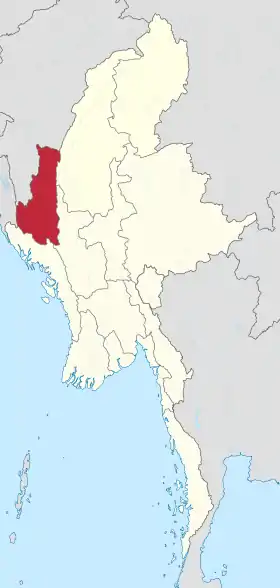Chin State
ချင်းပြည်နယ် | |
|---|---|
| Myanma transcription(s) | |
| • Burmese | hkyang: pranynai |
 | |
 Flag | |
 Location of Chin State in Myanmar | |
| Coordinates: 22°0′N 93°30′E / 22.000°N 93.500°E | |
| Country | |
| Region | Western Myanmar |
| Capital | Hakha |
| Government | |
| • Chief Minister | Ngun San Aung |
| • Cabinet | Chin State Government |
| • Legislature | Chin State Hluttaw |
| • Judiciary | Chin State High Court |
| Area | |
| • Total | 36,018.8 km2 (13,906.9 sq mi) |
| • Rank | 9th |
| Highest elevation | 3,070 m (10,070 ft) |
| Population (2014)[2] | |
| • Total | 578,801 |
| • Rank | 14th |
| • Density | 16/km2 (42/sq mi) |
| Demographics | |
| • Ethnicities | Chin |
| • Religions | Christianity 90.4% Buddhism 6.0% Laipian 1.1% Animism 0.4% Hinduism 0.1% |
| Time zone | UTC+06:30 (MST) |
| HDI (2015) | 0.556[3] medium · 7th |
Chin State (Burmese: ချင်းပြည်နယ်; MLCTS: hkyang: pranynai, pronounced [tɕʰɪ́ɰ̃ pjìnɛ̀]) is a state in western Myanmar. Chin State is bordered by Sagaing Division and Magway Division to the east, Rakhine State to the south, the Chittagong Division of Bangladesh to the west, and the Indian states of Mizoram to the west and Manipur to the north. The population of Chin State is about 488,801 according to the 2014 census, and its capital city is Hakha.[4]
The state is named for the Chin people, an ethnic group native to Chin State and neighboring Rakhine State. Much of the state is mountainous and sparsely populated, with few transportation links and low levels of economic development. It also has Myanmar's highest poverty rate, at 58%, according to a 2017 report.[5]
History
Post-Burmese independence
Upon Burma's independence from the United Kingdom in 1948, the Chin Hills Special Division was created, with its capital at Falam. Hakha later became the capital. However, three townships that are today part of present-day Chin State (Mindat, Kanpetlet and Matupi) were previously part of the Pakokku Hill Tracts of Pakokku District and Paletwa Township of the Arakan Hill Tracts, until 4 January 1974. On this date, the Chin Hills Special Division was granted state status and became Chin State.[6] Today, Chin State has little infrastructure and remains extremely poor and undeveloped.
"Chin National Day" is designated on 20 February to commemorate the "General Assembly of Chinland" held in 1948.[7] The first celebration of Chin National Day was held in 1951, but it was not recognized by the Myanmar government until the 2010s.[8]
Myanmar civil war
Chin State, like much of Myanmar, has been deeply affected by the Myanmar civil war since it broke out in 2021. Tens of thousands of Chin State residents have fled to neighboring Mizoram, India, and towns such as Thantlang were destroyed in the fighting.[9] Since the war broke out, several armed opposition groups have emerged calling themselves the Chinland Defense Force. The groups are reportedly funded by the Chin diaspora and by the National Unity Government of Myanmar, an opposition government-in-exile.[10]
On December 6th, 2023, the Chin National Front ratified the Chinland Constitution, proclaiming the state of Chinland.[11]
Administrative divisions

Districts and Townships
- Tedim District of Northern Chin State
- Tedim Township
- Tonzang Township
- Cikha Sub township
- Khaikam Town
- Falam District Central Chin State
- Falam Township
- Rihkhawdar Town
- Webula Town
- Hakha District of Central Chin State
- Hakha Township
- Surkhua Town
- Thantlang Township
- Hnaring Town
- Matupi District of Central and Southwestern Chin State
- Matupi Township
- Rezua Subtownship
- Lailenpi Town
- Paletwa Township
- Samee Subtownship
- Mindat District of Southeastern Chin State
- Mindat Township
- Makui Innu Town
- Kanpetlet Township
Hakha District was formed by the first Chin State Hluttaw emergency meeting No. 2/2012 on 1 June.[12] Matupi District was formed by the second Pyidaungsu Hluttaw regular meeting on 28 June 2017.[13][14]
Government
Executive
Legislature
Demographics
Demographics
| Year | Pop. | ±% |
|---|---|---|
| 1973 | 323,295 | — |
| 1983 | 368,949 | +14.1% |
| 2014 | 478,801 | +29.8% |
| Source: 2014 Myanmar Census[2] | ||
The people of Chin State are made up of many tribes which, though historically related, now speak divergent languages and have different cultural and historical identities. Some consider the name Chin an exonym, given by the Burmese and of unclear origin. Ethnic groups in Chin State include K' Cho, Zo, Laimi, Matu, Tedim, Mizo, Asho, Mara, Khumi, and Daai, among others.
Religion
Religion in Chin (2014)[15]
According to the 2014 Myanmar Census, Christians make up the vast majority of Chin State's population, at 91.5%.[16] Minority religious communities include Buddhists (6.1%), animists (1.2%), Hindus (1.1%), and Laipian (0.1%), including adherents of Pau Cin Hau, who collectively comprise the remainder of Chin State’s population.[16] 1.1% of the population listed no religion, or other religions, or were otherwise not enumerated.[16] Chin State is the only state in Myanmar with a majority Christian population.[17]
| Religious group |
Population % 1983 |
Population % 2014[15] |
|---|---|---|
| Christianity | 85.5% | 91.5% |
| Buddhism | 13.5% | 6.1% |
| Tribal | 0.5% | 1.2% |
| Hinduism | 0.3% | 1.1% |
| Laipian | 0.2% | 0.1 |
Education
According to official statistics,[18] Chin State had 25 high schools in 2003.
References
- ↑ "Union of Myanmar". City Population. Retrieved 10 April 2009.
- 1 2 Census Report. The 2014 Myanmar Population and Housing Census. Vol. 2. Naypyitaw: Ministry of Immigration and Population. May 2015. p. 17.
- ↑ "Sub-national HDI - Area Database - Global Data Lab". hdi.globaldatalab.org. Retrieved 13 September 2018.
- ↑ "Census Population Dashboard | MIMU". themimu.info. Retrieved 29 February 2020.
- ↑ "Myanmar Living Conditions Survey 2017". United Nations Development Programme. United Nations Development Programme. Retrieved 12 November 2023.
- ↑ "Myanmar Divisions". Statoids. Retrieved 18 November 2017.
- ↑ "Celebration Of 65th Chin National Day". Unrepresented Nations and Peoples Organization. 20 February 2013. Retrieved 18 November 2017.
- ↑ Cung, Zing. "Chin Identity and Chin National Day". Chin Community in Norway. Retrieved 18 November 2017.
- ↑ Fishbein, Emily (29 August 2023). "Myanmar's striking civil servants: Displaced, forgotten, but holding on". Al Jazeera. Retrieved 12 November 2023.
- ↑ Ghoshal, Devyjot (12 December 2021). "Insight: In Myanmar's Chin state, a grassroots rebellion grows". Reuters. Retrieved 13 November 2023.
- ↑ "The First Chin-Written Constitution: A New Template For Self-Determination?". The Irrawady. 26 December 2023. Archived from the original on 26 December 2023.
- ↑ http://www.mrtv3.net.mm/newpaper/46newsn.pdf Page 16, Col 1.
- ↑ Second Pyidaungsu Hluttaw, fifth regular meeting record (in Burmese), Pyidaungsu Hluttaw, p. 420
- ↑ Rezua
- 1 2 Department of Population Ministry of Labour, Immigration and Population MYANMAR (July 2016). The 2014 Myanmar Population and Housing Census Census Report Volume 2-C. Department of Population Ministry of Labour, Immigration and Population MYANMAR. pp. 12–15.
- 1 2 3 The 2014 Myanmar Population and Housing Census Census Report Volume 2-C (PDF). Department of Population Ministry of Labour, Immigration and Population. July 2016. pp. 12–15.
- ↑ "Laipian Pa Ni kibawl". ZomiDaily. archive.is. 29 December 2012. Archived from the original on 31 December 2012. Retrieved 18 November 2017.
- ↑ "Education statistics by level and by State and Division". Myanmar Central Statistical Organization. Archived from the original on 24 May 2008. Retrieved 19 April 2009.
External links
- WorldStatesman - Myanmar - States of Burma 1948-1974
- For more cultural information about the Chin see F.K. Lehman. 1963. The Structure of Chin Society;: A Tribal People of Burma Adapted to a Non-Western Civilization. University of Illinois Press.
- Stavanger Chin Organization
- The Chin National Front
- Chin Human Rights Organization
- Matupi Students Union
- Chin Community in Japan
- Chin Community in Norway
- Chin Community in Denmark
- Chinland Development and Research Society in Sweden
- Chin Community in Germany
- Chin Christian Fellowship in Denmark
- English- Chin Online Dictionary
- MITCS
- ZOGAM Home
- Vaphual news & articles on Zo people
- Chin Community Germany
- The official website of Zomi Reunification Organisation
- Institutes of Higher Education in Myanmar (January 2002) Archived 17 May 2019 at the Wayback Machine - arranged by state and division
